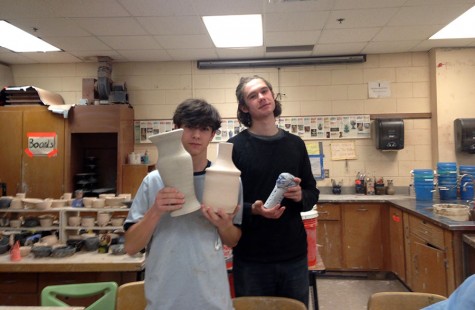Different ceramic methods provide creativity and variety to South students
April 11, 2016
There are two main ways to build the perfect piece in ceramics, throwing on a pottery wheel and handbuilding Many students at South choose to focus on one of the two methods, and use them to create a majority of their pieces.
This year’s ceramic teacher David Olson emphasized that it is for this reason that he teaches handbuilding to his students before demonstrating how to throw on a pottery wheel. The goal is to advance in both skills and then the students choose which one they prefer.
“I do the hand building first because once students get on the wheel, they get really enthusiastic, they don’t wanna go back to hand building,” commented Olson. He stressed that the danger in allowing students to develop only one skill is that not everyone will feel confident with their progress in the class.
When the students test the waters with throwing on the wheel, if they established a background with hand building prior to their experimentation with the wheel, they have something to fall back on. “Sometimes what happens is that students will try out the wheel for a while, and they will either get frustrated or they’ll decide that it’s not for them, and I find that if they have good hand building skills to go back to, they can go back to hand building and feel like they’re being successful,” Olson summarized.
Senior Theo Colby-Milbrath has been a ceramics student since freshmen year, but only recently has he refined his hand building skills. “I took ceramics freshmen year, but I wasn’t really that good at it, and most of my handbuilding has been done this year,” he expressed.
Colby Milbrath is a prime example of the dedication and effort it takes to develop a certain skill, and that many students change their minds about one technique to pursue the other.
Devoted ceramics student Tenzin Dohmeier has been using a pottery wheel since his freshmen year and finds the process to be less complex than hand building, but recognizes that in the end it is a personal preference. “It [throwing] is easier,” he stated simply.
While describing how the process could be viewed as difficult by beginners,he expressed “it depends, if you use bigger pieces it gets more difficult to center, but pulling up the clay is easier because there is more to work with, if you use less clay, it is easier to center, but then, there is less clay to work with,” said Dohmeier.
Because of the process of centering, pieces that are thrown are more rounded and smooth than many hand built pieces, however this also limits the shapes that can be created with throwing. Centering is the process if aligning your clay with the middle of the pottery wheel, this alows for pieces to be symetric and even.
Olson distinctly recognizes the difference between these methods. “The wheel is a great way to make functional things, but, you can also use the wheel as a starting point for sculpture, you can throw a shape on the wheel, and when it’s still soft, you can alter it in various sculptural ways,” He stated.
With students learning so many different techniques and art forms first quarter, Olson prefers to keep second quarter more open ended and free formed. “Once you get into the second quarter assignments, they’re more open ended assignments students can choose the technique that they want based on their interests and based on what they want to make,” he communicated.
Both throwing and handbuilding require patience and focus, Colby-Milbrath finds a certain therapeutic value to hand building that simply isn’t there in throwing. “It’s very cathartic and relaxing, it’s peaceful,” he conveyed. However, both Dohmeier and Colby-Milbrath agree that the creative process, is very loose and differs from person to person. They both feel as though they simply ‘go with the flow,’ while making their pieces. “I grab a lot of clay and see what happens. I have an idea of what I want to make, I will say that I want to make a bust of something, I made a bust of Batman that Tenzin really liked,” Colby-Milbrath joked.
Dohmeier self describes his creative process as spontaneous, and adaptable. “ I put the clay on the wheel, and see what happens, see what the clay wants to do, and whats going on. [It’s] not planned at all,” he concluded.
Colby-Milbrath goes on to explain that the tools you use for the two methods are vastly different. “[It’s] more like carving I would say, cause when you are throwing you are not really doing any carving, unless you are making the foot [the bottom of a ceramic piece],” he commented.
“I would just use a rib and a trimming tool for a foot if I was throwing. But in hand building, you get to use a lot more tools,” conveyed Colby-Milbrath.
While the techniques may seem intimidating, the ceramics studio is open most hours of the day, and Olson is almost always staying late in the studio, leaving it open for his students to learn and work on ongoing projecrts. “I am almost always here after school, I have some students come in after school, some students who come in during an open hour, and I am always okay with that as long as they’re here to work,” shared Olson.

Dohmeier (left) and Colby-Milbrath (right) pose next to pieces they have worked on this year. Colby Milbrath holds a hand built piece, while Dohmeier holds two pieces. Dohmeier put the finishing touches to the foot of his piece,and it has yet to be put in the kiln, a thermal chamber which changes clay to glass.




